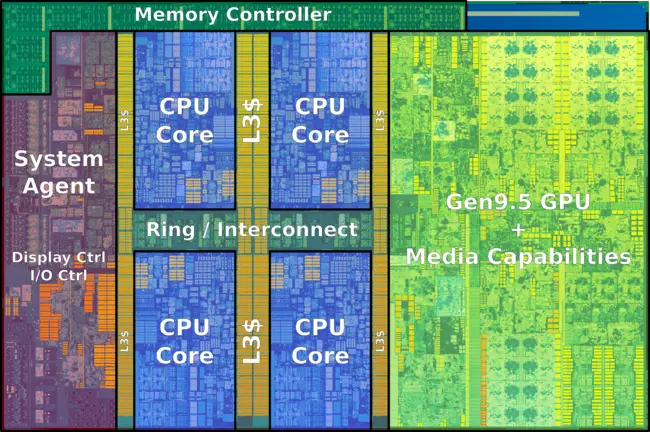From WikiChip
Difference between revisions of "intel/core i5/i5-7400t"
(die) |
|||
| Line 241: | Line 241: | ||
|rvi=No | |rvi=No | ||
}} | }} | ||
| + | |||
| + | == Die Shot == | ||
| + | {{see also|intel/microarchitectures/kaby_lake#Die|l1=Kaby Lake § Die Shot}} | ||
| + | A die shot of Intel's Kaby Lake [[Quad Core]] desktop processors: | ||
| + | |||
| + | : [[File:kaby lake (quad core).png|650px]] | ||
| + | |||
| + | |||
| + | : [[File:kaby lake (quad core) (annotated).png|650px]] | ||
Revision as of 13:07, 13 January 2017
Template:mpu Core i5-7400T is a 64-bit quad-core mid-range performance x86 desktop microprocessor introduced by Intel in early 2017. This chip, which is based on the Kaby Lake microarchitecture, is fabricated on Intel's 14nm+ process. The i5-7400T operates at 2.4 GHz with a TDP of 35 W supporting a Turbo Boost frequency of 3 GHz. The processor supports up to 64 GiB of dual-channel non-ECC DDR4-2400 memory and incorporates Intel's HD Graphics 630 IGP operating at 350 MHz with a burst frequency of 1 GHz.
This model has a configurable TDP-down frequency of 1.2 GHz.
Cache
- Main article: Kaby Lake § Cache
|
Cache Organization
Cache is a hardware component containing a relatively small and extremely fast memory designed to speed up the performance of a CPU by preparing ahead of time the data it needs to read from a relatively slower medium such as main memory. The organization and amount of cache can have a large impact on the performance, power consumption, die size, and consequently cost of the IC. Cache is specified by its size, number of sets, associativity, block size, sub-block size, and fetch and write-back policies. Note: All units are in kibibytes and mebibytes. |
|||||||||||||||||||||||||||||||||||||
|
|||||||||||||||||||||||||||||||||||||
Memory controller
|
Integrated Memory Controller
|
||||||||||||||
|
||||||||||||||
Expansions
|
Expansion Options
|
||||||||
|
||||||||
Graphics
|
Integrated Graphics Information
|
||||||||||||||||||||||||||||||||||||||||||||||||||||||||||||||||||||
|
||||||||||||||||||||||||||||||||||||||||||||||||||||||||||||||||||||
| [Edit] Kaby Lake (Gen9.5) Hardware Accelerated Video Capabilities | |||||||
|---|---|---|---|---|---|---|---|
| Codec | Encode | Decode | |||||
| Profiles | Levels | Max Resolution | Profiles | Levels | Max Resolution | ||
| MPEG-2 (H.262) | Main | High | 1080p (FHD) | Main | Main, High | 1080p (FHD) | |
| MPEG-4 AVC (H.264) | High, Main | 5.1 | 2160p (4K) | Main, High, MVC, Stereo | 5.1 | 2160p (4K) | |
| JPEG/MJPEG | Baseline | - | 16k x 16k | Baseline | Unified | 16k x 16k | |
| HEVC (H.265) | Main, Main 10 | 5.1 | 2160p (4K) | Main, Main 10 | 5.1 | 2160p (4K) | |
| VC-1 | ✘ | Advanced, Main, Simple | 3, High, Simple | 3840x3840 | |||
| VP8 | Unified | Unified | N/A | 0 | Unified | 1080p | |
| VP9 | 0 | 2160p (4K) | 0, 2 | Unified | 2160p (4K) | ||
Features
[Edit/Modify Supported Features]
Die Shot
- See also: Kaby Lake § Die Shot
A die shot of Intel's Kaby Lake Quad Core desktop processors:
Facts about "Core i5-7400T - Intel"
| Has subobject "Has subobject" is a predefined property representing a container construct and is provided by Semantic MediaWiki. | Core i5-7400T - Intel#io + |
| device id | 0x5912 + |
| has advanced vector extensions | true + |
| has advanced vector extensions 2 | true + |
| has ecc memory support | false + |
| has feature | Advanced Vector Extensions +, Advanced Vector Extensions 2 +, Advanced Encryption Standard Instruction Set Extension +, Turbo Boost Technology 2.0 +, Enhanced SpeedStep Technology +, Intel VT-x +, Intel VT-d +, Transactional Synchronization Extensions +, Memory Protection Extensions +, Software Guard Extensions +, Secure Key Technology +, OS Guard + and Identity Protection Technology + |
| has intel enhanced speedstep technology | true + |
| has intel identity protection technology support | true + |
| has intel secure key technology | true + |
| has intel supervisor mode execution protection | true + |
| has intel turbo boost technology 2 0 | true + |
| has intel vt-d technology | true + |
| has intel vt-x technology | true + |
| has transactional synchronization extensions | true + |
| has x86 advanced encryption standard instruction set extension | true + |
| integrated gpu | HD Graphics 630 + |
| integrated gpu base frequency | 350 MHz (0.35 GHz, 350,000 KHz) + |
| integrated gpu designer | Intel + |
| integrated gpu execution units | 24 + |
| integrated gpu max frequency | 1,000 MHz (1 GHz, 1,000,000 KHz) + |
| integrated gpu max memory | 65,536 MiB (67,108,864 KiB, 68,719,476,736 B, 64 GiB) + |
| l1$ size | 256 KiB (262,144 B, 0.25 MiB) + |
| l1d$ description | 8-way set associative + |
| l1d$ size | 128 KiB (131,072 B, 0.125 MiB) + |
| l1i$ description | 8-way set associative + |
| l1i$ size | 128 KiB (131,072 B, 0.125 MiB) + |
| l2$ description | 4-way set associative + |
| l2$ size | 1 MiB (1,024 KiB, 1,048,576 B, 9.765625e-4 GiB) + |
| l3$ description | 12-way set associative + |
| l3$ size | 6 MiB (6,144 KiB, 6,291,456 B, 0.00586 GiB) + |
| max memory bandwidth | 35.76 GiB/s (36,618.24 MiB/s, 38.397 GB/s, 38,397.008 MB/s, 0.0349 TiB/s, 0.0384 TB/s) + |
| max memory channels | 2 + |
| max pcie lanes | 16 + |
| supported memory type | DDR3L-1600 + and DDR4-2400 + |
| x86/has memory protection extensions | true + |
| x86/has software guard extensions | true + |

